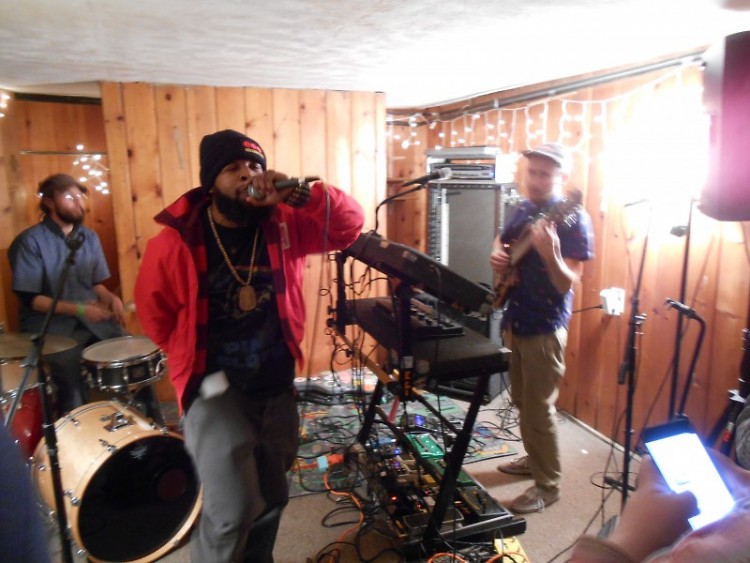Live music, friends and food, all inside the homes of Eastown: this is the premise of the Lamplight Music Festival.
The Lamplight Music Festival, which was held Nov. 1-3, was three days of house shows, food and workshops in Eastown. This year marks the festival’s second year of existence. John Hanson, an Eastown resident, is one of the founders and organizers of the festival.
The Festival was founded as a continuation of what already happens in Eastown, Hanson says. He says his experience as a musician and his exposure to different types of shows influenced why he chose to help found the festival.
“I value house shows the most because there is a genuine quality that is worth more than money,” Hanson says. “There is a genuine connection between artists and the audience.”
A house show is a performance by a band inside a person’s house. The show is either held in the front room or basement depending on how the house is set up.
Justin Majetich, a house show host and performer at this year’s festival, shares Hanson’s sentiments about house shows.
“House venues, which are so evocative of the localized Eastown cultural, blur the lines between a hangout and a festival, [and are] very homey,” Majetich says.
This year the organizers asked five residents to open their homes to the festival. The five houses were given names for the festival. The houses were called the Bird House, the Hen House (both located on Benjamin Street), the Neighborhood House, Waffle House and House of Pancake (each located on Sigsbee Street).
Hosting a house show for the festival is not a hard task, Majetich says. The only requirements are to clean up the house a bit and open the doors, and the organizers did the rest of the work, he expains.
On Saturday all the afternoon and early evening shows were held in the Bird House and the Neighborhood House, which are front room venues. All the late evening shows were held in either the Waffle House or the House of Pancake, which are basement venues.
In the Bird House the bands were set up in the front room, which had all the furniture removed except two chairs and two lamps that lit the room. There were speakers and microphones set-up for the bands. The audiences sat on the floor, while the bands sat on the chairs.
Eric Domke, a festival attendee, enjoyed the informal environment of the festival.
“It’s a different way to experience music,” Domke says. “It allows you to talk to people, audience and performers more comfortably.”
The band Mandolin Orange from Chapel Hill, N.C. performed at the Bird House before an audience of more than 20 people who crammed into the space. The band performed acoustically.
Andrew Marlin, a member of the two-person band Mandolin Orange says he enjoys these types of venues.
“We’ve done house shows before,” says Marlin. “It is cool that people here are interested in different styles of music and that people are willing to listen.”
The festival showcases many different styles of music, including Spanish rock, folk, folk rock, rap, free-style poetry, dark rock and many other styles. Showcasing the different styles of music is following the goals of the organizers, Hanson said. He also mentioned the festival was organized by a small group of people.
“As simple as it is, myself and few other people carry the showcase,” Hanson said, “and if we aren’t excited then we don’t expect other people to be excited.”
The festival began around noon and went past midnight on all nights of the festival. During the festival, food and drink was provided for in the cost of the festival. The food was an assortment of different types of food. Drinks consisted mainly of apple cider, water and beer.
The festival cost $15 for a one-day pass and $35 for a weekend pass. None of the money returns to the organizers, Hanson says. All the money goes to the bands, food, people who provide services and for materials like the website, he says.
Hanson said he doesn’t believe the festival could happen without the Eastown community.
“It couldn’t happen without this great community, the people, the artists, the food culture and walkability of Eastown,” Hanson says. “It couldn’t be possible without DITGR [Do It Together Grand Rapids], a new embodiment carrying the torch of the house show scene in the city.”
Hanson believes anyone can change their community.
“I would like to tell people to do the same thing,” Hanson says. “Make stuff, make it up, make this place what you want it to be.”
The Rapidian, a program of the 501(c)3 nonprofit Community Media Center, relies on the community’s support to help cover the cost of training reporters and publishing content.
We need your help.
If each of our readers and content creators who values this community platform help support its creation and maintenance, The Rapidian can continue to educate and facilitate a conversation around issues for years to come.
Please support The Rapidian and make a contribution today.
